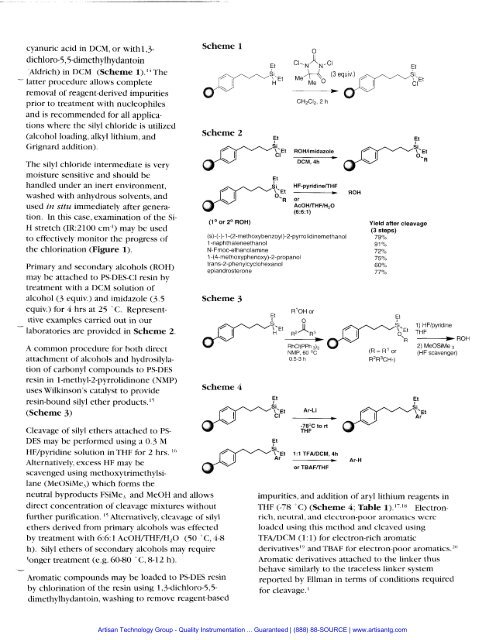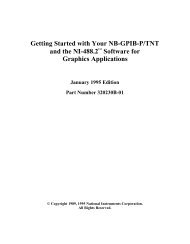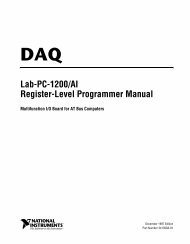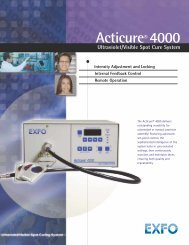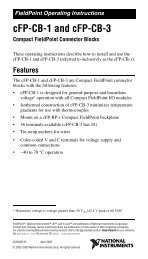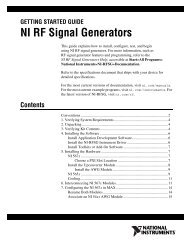cyanuric acid in DCM, or withl,3-dichloro-5,5-dimethylhydantoinAldrich) in DCM (Scheme l).liThe- latter procedure allows completeremoval of reagent-derived impuritiesprior to treatment with nucleophilesand is recommended for all applicationswhere the silyl chloride is utilized(alcohol loading, alkyl lithium, andGrignard addition).The silyl chloride intermediate is verymoisture sensitive and should behandled under an inert environment,washed with anhydrous solvents, andused in situ immediately after generation.In this case, examination of the Si-H stretch (IR:2100 cm ') may be usedto effectively monitor the progress ofthe chlorination (Figure 1).Primary and secondary alcohols (ROH)may be attached to PS-DESK1 resin bytreatment with a DCM solution ofalcohol (3 equiv.) and imidazole (3.5equiv.) for 4 hrs at 25 " C. Represent-~tivexamples carried out in our- laboratories are provided in Scheme 2.A common procedure for both directattachment of alcohols and hydrosilylationof carbonyl compounds to PS-DESresin in 1-methyl-2-pyrrolidinone (NMP)uses Wilkinson's catalyst to provideresin-bound silyl ether products.li(Scheme 3)Scheme 1Scheme 2Cleavage of silyl ethers attached to PS-DES may be performed using a 0.3 MHF/pyridine solution in THF for 2 hrs. "'Alternatively, excess HF may bescavenged using methoxytrimethylsilane(MeOSiMe,) which forms theneutral byproducts FSiMe, and MeOH and allowsdirect concentration of cleavage mixtures withoutfurther purification. li Alternatively, cleavage of silylethers derived from primary alcohols was effectedby treatment with 6:6: 1 AcOH/THF/H,O (50 " C, 4-8h). Silyl ethers of secondary alcohols may requirelonger treatment (eg. 60-80 " C, 8-12 h).-Aromatic compounds may be loaded to 13-DES resinby chlorination of the resin using 1,3-dichloro-5,5-dimethylhydantoin, washing to remove reagent-based?Ft-SiSi\\Et ROHIimidazole \ 'EtCI 0.DCM, 4hR&HF-pyridineTTHF\'Et0. R orAcOH/THF/H20(6:6:1)ROH(1 or 2O ROH) Yield after cleavage(3 steps)(s)-(-)-l-(2-methoxybenzoyl)-2-pyrrolid1nemethanol 79%1 -naphthaleneethanol 91%N-Fmoc-ethanolamine 72%1 -(4-methoxyphenoxy)-2-propanol 75%trans-2-phenylcyclohexanol 60%epiandrosterone 77%Scheme 3Scheme 4Si\'~tCI6.iAr-Li\'Et, Ar-78OC to rtTH F1) HFIpyridineTH F2) MeOSiMe(HF scavenger)impurities, and addition of aryl lithium reagents inTHF (-78 " C) (Scheme 4; Table 1). '- IX Electronrich,neutral, and electron-poor aromatics wereloaded using this method and cleaved usingTFA/DCM (1 : 1) for electron-rich aromaticderivatives"' and TBAF for electron-poor aromatics.'"Aromatic derivatives attached to the linker thusbehave similarly to the traceless linker systemreported by Ellman in terms of conditions requiredfor cleavage. 'ROH<strong>Artisan</strong> Technology Group - Quality Instrumentation ... Guaranteed | (888) 88-SOURCE | www.artisantg.com
Table 1ArReferencesMethodYieldWoolard, F. X.; Paetsch, J.; Ellman, J. A. J 0%. Chem.l997,62,6102.Greene,T.W.;Wuts, P. G. M. in Protecting Groupsin Organic Synthesis, John Wiley and Sons, 1991,68.Kocienski, I? J. in Protecting Groups, Thieme,1994, 28.Farral, M. J.; Frechet, J. M. J. J. Org. Chem. 1976,41,3877.Chan,T.; Huang, WJ. Chem. Soc., Chem. Commun.1995, 909.Randolph, J.T.; McLure, K. E; Danishefsky, S.J.JAm. Chervz. Soc. 1995, 117,5712.Stover, R. D. H.; Lu, I?; Frechet,]. M. J.J. PolymerBulletin 1991, 25,575.Stranix, B. R.; Liu H. Q. ; Darling, G. D. J. Org. Chem.l997,62,6183.Boehm,T. L.; Showalter, H. D. H.J. Org. Chem.1996,61,6498.Newlander, K.A.; Chenera, B.;Veber, D. E;Yim, N.C. E; Moore, M. L.J. Org Chem., 1997,62,6726.For alcoholysis of hydrosilanes with TBAF in solution,see:Tanabe,Y.; Okumura, H.; Maeda,A.;Murakami, M. Tetrahedron Lett. 199435,8413.For rhodium-catalyzed alcoholysis of hydrosilanesin solution, see: Doyle, M. P; High, K. G.; Bagheri,V; Pieters, R.J.; Lewis, I? J.; Pearson, M. M. JI Org.Chem. l990,55,25.For hydrosilylation of carbonyl compounds insolution, see: a). Ojima, I.; Nihonyanagi, M.;Kogure, T.; Kumagai, M. ; Horiuchi, S. ;Nakatsugawa, K. J. Organorvzet. Chem. 1975,94,449. b). Mukaiyama,T.; Izumi, J.; Shiina, I. Chem.Lett. 1997, 187. c). Fujita, M.; Hiyama,T. J Org.Chem. 1988,53,5405.Representative procedure for chlorination of PS-DES resin:To a 5 ml round bottom flask wasadded under argon 100 mg of PS-DES resin (0.75mmol/g, 0.075 mmol), and a small magnetic stirringbar. 44 mg (0.225 mmol) 1,3-dichloro-5,5-dimethylhydantoin in 0.8 mI. DCM was thenadded.The mixture was stirred at room tempera-ture. After 2 h, the mixture was washed withanhydrous DCM (3 x 3 mL) and anhydrousTHF(3 x 3 mL) under argon.The resin was irnmediatelyused for further transformations. -15. Hu,Y; Porco, J.A.,Jr.., Tetrahedron Lett. 1998,39,2711.16. After cleavage, the resin was washed with THF (3x).The filtrate was treated with a saturated solutionof NaHCO,, and an EtOAc solution ofanthracene (internal standard) was added. Afterextraction with EtOAc, the organic layer wasused for GC quantification.17. Loading qf 4-phenoxyphenyl bromide: To 500mg of PS-DES resin (0.75 mmol/g, 0.375 mmol)was added 220 mg of 1,3-dichloro-5,5-dimethylhydantoin(1.125 mmol) in 4 mL DCM underargon.The mixture was stirred for 2 h at st. Theresin was washed with anhydrous DCM (3 x 7mIJ and anhydrous THF (3 x 7 mL) under argon.To the resin was added at -78 " C 5 equiv. of 4-phenoxyphenyllithium (generated by treating 4-phenoxyphenyl bromide with 1 equiv. of nBuLiat -78" C for 1 h) in 5 mL THE The reaction mixturewas allowed to warm up to room temperature(4 h).The resulting mixture was washedwithTHF (3 x 7 mL),THF/H,O (1:l) (3 x 7 mL),THF (3 x 7 mL), DCM (3 x 7 mL) and driedunder vacuum for 12 h to give the 4-phenoxyphenylsilyl resin. IR (cm'): 1239.8 (Ar-0). -18. Loading of 3-bromoyuinoline: To a t-HuLi solutionin pentane (2 equiv.) was added dropwise aTHF solution of 3-bromoquinoline (1 equiv.)under argon at -78 "C.The mixture was stirred atthis temperature for 5 mins before transferringvia cannula to freshly prepared PS-DES-SiCI resin(- 100 mg) at -78 " C.The reaction mixture wasallowed to warm up to room temperature in 4hrs.The resin was washed withTHF (3 x 7 mL),THF/H,O (1:l) (3 x 7 mL),THF (3 x 7 mL), DCM(3 x 7 mL) and dried under vacuum for 12 h.19. To the 4-phenoxyphenyl silyl resin (100 mg) wasadded TFA/DCM (1: l,3 mL).The mixture wasstirred at 25 OC for 3 h.The resin was filteredand washed with DCM (3 x 2 mL).The combinedfiltrate was treated with saturatedNaHCO,.The organic layer was used for GCquantification (anthracene as internal standard).20. Treatment of the silyl quinoline resin with TBAF(1.0 M in THF, S n1L) for 12 h followed byextraction of the product into DCM led to therecovery of quinoline in 58% yield (GC quantificationusing anthracene as internal standard).General Reference for PS-DES -Hu,Y.; Porco,J.A. Jr.; Labadie, J.; Gooding O.;Trost,B.M., J. Org. Chem., 1998, 63,4518.<strong>Artisan</strong> Technology Group - Quality Instrumentation ... Guaranteed | (888) 88-SOURCE | www.artisantg.com


